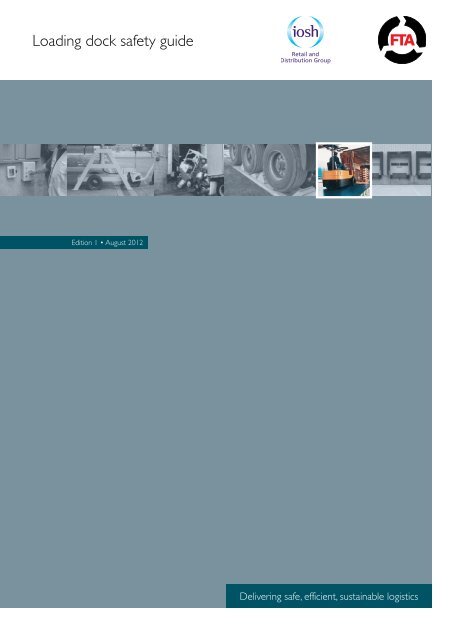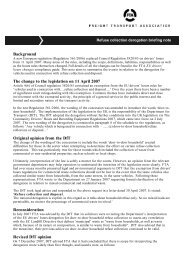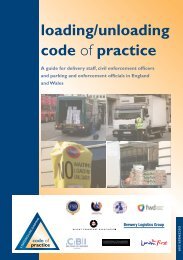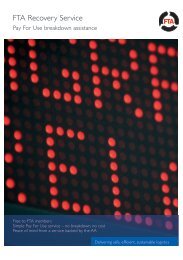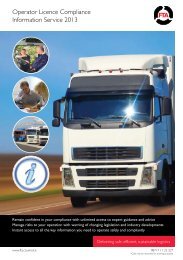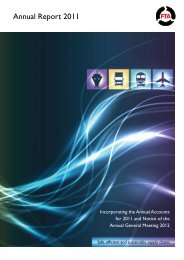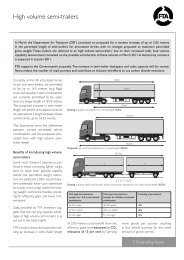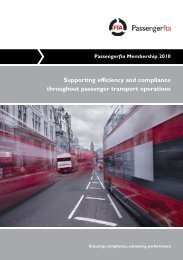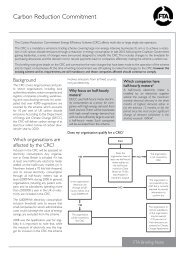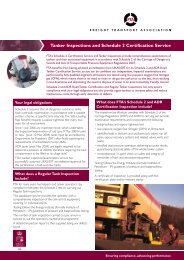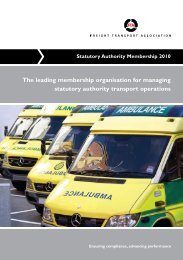Loading dock safety guide - Freight Transport Association
Loading dock safety guide - Freight Transport Association
Loading dock safety guide - Freight Transport Association
Create successful ePaper yourself
Turn your PDF publications into a flip-book with our unique Google optimized e-Paper software.
Control measuresOnce hazards have been suitably assessed and significant risksidentified, legislation requires control measures to be putin place to deal with them. This document identifies somecommon industry control measures for the key hazardsidentified in section one. Some control measures can helpmitigate more than one hazard – for example the use of wheelchocks can mitigate both drive-aways and vehicle creep, and thisis reflected within this chapter.Control measures should never be considered a one-sizefits-allsolution. Different control measures will suit differentoperations. Many organisations have a combination of themeasures outlined in this chapter and most have adapted themto suit their own organisational needs and processes. Whatevermeasures are used, they will need to form part of a safesystem of working that includes reasonably practicable controls.Organisations should document and effectively communicatetheir safe systems.Drive-away control measuresSignals, signs and barriersSignals, such as red/green traffic lights are commonly used atloading bays to indicate when it is safe (green) or not safe (red)to move a vehicle. They are generally positioned on the side ofthe <strong>dock</strong> door that the driver will be on, once the vehicle hasbeen reversed onto the <strong>dock</strong>.it is safe to open the door to commence loading/unloading.This process is reversed when the vehicle/trailer is ready to bedriven off the bay – the warehouse staff activate the mechanismthat changes the warehouse indicator and turns the outsidetraffic light to green. When designing systems with lights, itshould be remembered that glare from sunlight can significantlyaffect their visibility and so they should be positioned carefullyand shaded to increase their effectiveness.Other types of manual sign and barrier can also be used toshow when a vehicle can be driven on and off a loading bay.For example, a steering wheel cover or a stop sign or barrierthat is at the right height to be seen by the driver. These relyon robust procedures to ensure they are always used, andworkers positioning such signs or barriers could be put at risk.For example, it may be necessary to control the movements ofother vehicles in adjacent bays while signs are being put in placeor removed.Although these systems can be effective, most do not actuallyprevent a vehicle from moving away and so rely entirely onoperatives following the signals and, of course, the signalsworking correctly. This can be more difficult to manage whendealing with visiting drivers, and especially those whose firstlanguage may not be English.Key controlKey control systems are most commonly found in goods-inoperations – where semi-trailers (which usually remain coupledto tractor unit) or rigid vehicles are unloaded at a depot.Visiting drivers (whether employed by suppliers orsubcontractors or other parts of the occupiers’ organisation)are asked to hand over their ignition keys whilst the vehicle isbeing unloaded. These systems are often used in conjunctionwith other control measures, such as traffic light signals and canrange from the relatively simple locked cupboard, to a moresophisticated system that is linked automatically to the loadingbay doors. Automatic systems use electronic fobs placed withina panel, which unless activated when the vehicle’s keys areattached, will not allow the particular bay door to be opened.Similarly, when the loading bay door is open, the fob cannot beremoved from the panel. An example of a detailed safe systemof work for this type of key control can be found in the Annex:Tools chapter at the end of this <strong>guide</strong>.Indicator lights inside the warehouse at each loading bay areoften used in conjunction with these to inform warehouse staffthat the external traffic lights are set to red and that it is safe toopen the loading bay doors. These systems generally require thedriver to activate the light once the vehicle/trailer is positionedon the <strong>dock</strong>, which indicates to those in the warehouse thatOther key control systems attach the vehicle keys to a hookon a wire on the back of the loading door. These wires pull thekeys out of reach when the loading bay door is open.Where possible, it is preferable for visiting drivers to beaway from the vehicles whilst they are being loaded andonly permitted back into them once it is safe to do so. SomeAn FTA <strong>guide</strong>: <strong>Loading</strong> <strong>dock</strong> <strong>safety</strong> <strong>guide</strong> 5
organisations only allow their own shunter drivers to back ontoand off loading bays, asking visiting drivers to drop trailers orvehicles in designated parking areas. However, in these cases,visiting drivers should be provided with a safe waiting area, toensure they are not put at risk as pedestrians on a busy site.Similarly, where drivers need to observe loading, they will needa safe place to do this.Key control systems rely on drivers having only one set of keys(or handing in all sets they have on them), so safe systems ofwork should include asking the drivers if they carry any spares,and if so, handing these in too.Trailer airline locking systemsUncoupled semi-trailers present another opportunity to preventdrive-ways by preventing the trailer brake coupling (known asthe suzie) from being attached to a tractor unit or shunter.Cautionary note!If a vehicle and trailer is equipped with an ElectronicBraking System (EBS) it is possible under certainconditions that disconnecting the emergency (red) airlinewill NOT activate the fail-safe brakes on the trailer. It istherefore possible under certain conditions for a vehicleand trailer combination to be moved with the airlinecouplings disconnected which is extremely dangerous. Allairlines and electrical suzies must be correctly connectedbefore before moving a tractor and trailer combination.There are various methods of achieving this, such as a padlockplaced over the connection as well as purpose-built attachments.The key to the airline lock is then controlled by being put in asafe position, which is usually connected with the loading baydoor operation. For example, purpose-built systems use theairline-lock key to energise the loading bay door – it will notopen without the key being in position.When the brake line is uncoupled, fail-safe brakes are appliedto the trailer (note that these brakes should always be used inconjunction with applied trailer parking brakes to prevent thetrailer moving). By locking the trailer brake coupling, the trailercannot be coupled up to a motor vehicle and moved.6 An FTA <strong>guide</strong>: <strong>Loading</strong> <strong>dock</strong> <strong>safety</strong> <strong>guide</strong>
Other systems have a tube connection built into the wall of theloading <strong>dock</strong>, so the padlock key can be attached to a hook on awire that is lifted out of reach when the loading bay door is opened.Most wheel chock systems rely on the placing of individualchocks against the wheels of the vehicle or trailer. Chocksneed to be suitable for the type of vehicle they are expectedto restrain and can also be affected by the type of surface it isbeing used on, as well as the weather conditions.A robust safe system of work covering the use of wheel chocksis important, as workers who put them in place and removethem can potentially be at risk if working where there aremoving vehicles. It may be necessary to control the movementsof other vehicles in adjacent bays while chocks are put in placeor removed. Supervision and monitoring of their use can alsobe difficult. Because loading bays are often positioned closelytogether, it can be difficult to easily verify if chocks are in place.For this reason, they are often brightly coloured, and the use ofmirrors or cameras can assist.Automatic wheel chock systems are available that can be builtinto the <strong>dock</strong> approach at ground level. They can be operatedautomatically and thus remove the need for workers tomanually place and remove chocks. They need to be used inconjunction with a robust system to ensure they are activatedand de-activated at the appropriate time. Most automaticwheel chocks usually work in conjunction with <strong>dock</strong> traffic lightsystems.<strong>Loading</strong> bay door locking systemsMany of the control measures described in this section canoperate in conjunction with an automated or manually-operatedloading bay door system.Doors are typically locked when signals are on red, ignition keyshave not been handed over, or semi-trailer airlines are not locked.Drive-away and vehicle creep controlmeasuresChocks and other restraintsA simple and cost-effective way toprevent a vehicle moving is to placelarge wedges of hard material, orchocks, against the wheels to preventthe vehicle moving.Other restraint systems are also available, such as those whichclamp on to a part of the vehicle, such as the rear under-runbar. These can be mechanically or hydraulically operated andalso are often used in conjunction with traffic light systems.However, without a system to ensure the vehicle is not movedwhen restrained, some vehicles simply rip less robust restraintsout of their moorings or alternatively cause significant damageto the vehicle. Also these systems may not be suitable for allvehicle or trailer types – for example double-decked trailers.An FTA <strong>guide</strong>: <strong>Loading</strong> <strong>dock</strong> <strong>safety</strong> <strong>guide</strong> 7
professores são denominados pelo MEPES como monitores, mas dentro do ambiente da unidade escolar elesnão deixam de se referir a si como professores.Estes professores são contratados por meio de seleção de currículo pelo MEPES, e que passa tambémpelo crivo da Associação de cada escola. Sua formação é tanto na área técnica agrícola, como de matériasespecíficas como letras, matemática, etc. Um mesmo professor, dependendo de sua formação e capacidade,ministra mais de uma matéria entre as técnicas e as do currículo obrigatório. A verba destinada ao pagamentodesses é repassada pelo governo estadual do Espírito Santo para o MEPES, que contrata e demite osmonitores.Em sua maioria, os professores permanecem nas escolas durante a semana junto com os jovens. CadaEFA tem um arranjo diferenciado para acomodar aos professores. Na EFA Olivânia existem casas para osmonitores que tem sua própria família, e uma casa ocupada pelos que não são casados. Já na EFA Castelo,eles dormem em alojamentos junto aos estudantes, sendo que possuem quartos separados para eles.De forma a garantir que todas as atividades ocorram, um dos monitores sempre fica como responsáveldo dia. Segundo o Regimento Comum das EFA’s do MEPES, essa é a coordenação diária, responsável em darapoio às atividades de natureza pedagógicas e administrativas. Esse é sempre um dos professores da EFA quevão se revezando durante a semana. O responsável do dia permanece em tempo integral na escola,monitorando todas as tarefas realizadas, inclusive nos chamados "serões noturnos" que são as atividadesrealizadas depois do jantar, esses se alternando entre livres e obrigatórios como é o caso da chamadacelebração (onde realizam um "momento de reflexão"). Além dessa responsabilidade, qualquer ocorrência forada normalidade da rotina escolar, o coordenador diário fica incumbido de acompanhar e tentar solucionar ocaso, desde uma simples discussão entre estudantes até casos de ferimentos e doenças.Para cuidar da parte da cozinha e da limpeza da unidade escolar, estas contam com uma equipe deprofissionais em sua maioria cedidas pela prefeitura, ou antigas funcionarias do MEPES. De acordo com osconvênios de cada escola também é cedido um funcionário que cuida da parte de secretaria escolar (organiza adocumentação dos estudantes). O número desses funcionários tem uma grande variação dependendo do tipode convênio estabelecido pela escola e as prefeituras. Algumas EFA’s conseguem verbas da prefeitura onde selocalizam, não só para pagamentos desses funcionários, como também conseguem verbas paracomplementarem a alimentação dos jovens, visto que esses pagam entre R$ 13,00 a R$ 18,00 por sessão naescola para fins de alimentação. Alguns educandos subsidiam esse valor com a produção das terras de suasfamílias, esse é o caso da EFA Olivânia e EFA Castelo.As prefeituras também disponibilizam, de acordo com o convênio de cada escola, transporte escolarpara os estudantes. Este geralmente passa pela estrada principal da região para poder recolher as crianças ejovens. Outra parte desses vem de transporte próprio, seja levado pela família, seja indo de moto para a escola(ficando essa guardada a semana toda na escola). Em algumas escolas, como no caso da EFA de Olivânia,nem todos os estudantes ficam no sistema de internato por morarem na comunidade próxima, e fazem ocaminho casa-escola e escola-casa todos os dias.Todos esses convênios são articulados entre prefeituras, EFA's (através da Associação de Pais eMEPES), além de um trabalho dos diretores de sempre estarem atentos as administrações municipais, sobrepossibilidades de novas verbas para escola, de tentarem emendas com parlamentares que se simpatizem comas EFA's, e vários outros canais.4. A vida e a rotina de um estudante na EFA e o dia-a-dia pedagógicoGeralmente, quando um estudante entra numa escola família é por já haver o contato com o meio rural(inclusive é pré-requisito fundamental para se matricular). Seus pais, no mais comum, têm neles a esperançada continuidade no campo e também o sonho de dar condições melhores para o futuro, assim, quando ouvemfalar de um projeto inovador, que garantirá não a fixação, mas o direito de escolha - um leque deoportunidades-, depositam sua confiança nesse.Assim é o caso do agricultor Luis Brambati, que visitamos na comunidade rural de Olivânia, um dosmembros da associação de pais, que colocou sua filha Liliane na EFA Olivânia, apostando em uma alternativa
Annexes: Tools1: Safe system of work example documentsIncludes:Reversing onto loading baysKey control systemShunting operationsSusie trailer lock operation<strong>Loading</strong>2: Dock, vehicle/trailer height and buffer position example survey3: HSE site inspection – workplace transport checklist12 An FTA <strong>guide</strong>: <strong>Loading</strong> <strong>dock</strong> <strong>safety</strong> <strong>guide</strong>
1: Safe system of work documents – example ASafe Working PracticeReversing Vehicles onto <strong>Loading</strong> BaysWhy have this SWP? In 2010 most RTC’s happened whilst reversingTools and PPEHi-Viz, Safety Shoes, GlovesKey safe behaviour/safe conditionsNotes1 Always use <strong>safety</strong> gloves Protects hands while completing manual handling tasks, eg opening barn doors anduncoupling2 Always use hazard lights while reversing in yard andmove at slow speed3 Check that the Green Light is on. Never use a bayif the lights are not working4 Pull forward into correct position for reversingThis is to warn other yard users that you are about to reverse and slow speedreduces impact to buffers and allows greater manoeuvrabilityCheck there are no obstructions, pedestrians in the vicinity. DO NOT reverse ontothe bay if there are manoeuvring vehicles either side of your allocated bay. Do notreverse onto a bay showing a red light5 Open and secure barn doors, and remove numberplate6 Re-enter the cab Always use three points of contact entering cab7 When safe to do so, reverse onto loading bay withoffside wheels of trailer running parallel with the<strong>guide</strong>lines. This will ensure that the rear of vehicle issquarely parked onto the bay.• Drivers must reverse all the way back• Shunters must stop before making contact withthe bay and lower the trailer8 When vehicle is located on bay apply vehicle handbrake, select neutral and switch off engine9 Proceed to uncouple the unit and trailer followingrelevant SWPs for the type of unit you are driving10 Move unit forward from beneath the uncoupledtrailer11 Collect the Salvo from the loading bay storage box12 Fit the Salvo onto the trailer emergency air linecoupling and remove the Castell keyRemember to put the trailer park brake onEnsure clear visibility in everydirection at all times, if unsureask for assistance13 Take the key and insert it into the Salvo lightcontrol unit and turn it, the traffic light will thenturn to REDCommunication between trailers on loading bays and personnel in the warehouse viathe <strong>dock</strong> door is strictly prohibitedAn FTA <strong>guide</strong>: <strong>Loading</strong> <strong>dock</strong> <strong>safety</strong> <strong>guide</strong> 13
1: Safe system of work documents – example BSafe System of WorkSalvo System – Susie Trailer LockPERSONAL PROTECTIVE EQUIPMENTSAFETY WARNINGSMANDATORY:OPTIONAL:(SITE SPECIFIC)REFERENCES:RA-DIST-CENT-020A (M)Safety <strong>guide</strong>linesThe designated PPE must be worn and Safety Warnings observed at all times where appropriate.Gloves will be made available if requested for this procedure.Before you begin and throughout the procedure, ensure that the area you are working in is clean and tidy.Vehicles must be parked in the designated areas specified at each site and must not obstruct any walkway.ALWAYS be aware of pedestrians who have Right Of Way. You must STOP for them.ENSURE that you adhere strictly to all Manual Handling techniquesBefore reversing, ensure that the allocated loading bay traffic light is GREEN and that the vehicles’ hazard warning lights are on. If theloading bay door is open or opens, do not proceed. NEVER reverse onto or drive away from a loading bay showing a RED or NOlight unless under the directive of Logistics or Warehouse management staff.When reversing, make sure it is safe to do so by using your mirrors and, if being assisted onto a loading bay, personnel must be in viewat all times. If not, stop.The salvo lock weighs approx 1kg. Check and ensure that the equipment you are about to use is in good working condition, If not ora fault develops, inform a member of the Logistics or Warehouse management staff. During the course of normal use, it may becomedirty, greasy and slippery.Do not un/attach the salvo system unless standing on the tractor unit platform. This ensures that the driver is protected from anymoving vehicles and eliminates the requirement to unnecessarily use ladders etc to gain access to the trailer susie connectors.Drivers must follow site protocols in the event of restricted access to the warehouse and the operation of loading bay doors and <strong>dock</strong>levellers. These will be advised upon arrival at each site by the logistics office or designated yard marshal.<strong>Loading</strong> bay doors and <strong>dock</strong> leveller designs and operational controls vary from site to site. Do not operate unless appropriate traininghas been completed.Un/loading must not commence with the tractor unit attached to the trailer.All pre-departure checks including load integrity must be completed as directed in the driver’s handbook.Under NO circumstances must the driver attempt to move a trailer off the loading bay with a salvo lock in situ.Sign-off to verify that briefing and practical demonstration has been given to and successfully completed by:Trainer name (print):____________________________________Employee Name (print):__________________________________Trainer signature:_______________________________________Employee signature:_____________________________________Date:_ _______________________________________________Employee number:______________________________________14 An FTA <strong>guide</strong>: <strong>Loading</strong> <strong>dock</strong> <strong>safety</strong> <strong>guide</strong>
1: Sample safe system of work documents – example B10 The tractor unit can only be uncoupled from the trailer once the salvo lock is attached and is then parked up in the designated area11 The roles and responsibilities of, and the interaction between, drivers and warehouse staff are clarified by the respective site ruleswhich accommodate varying loading bay layouts and operational requirements12 On some sites, the driver is responsible for giving the salvo key to and advising the warehouse staff that the trailer has been parked onthe loading bay and is ready for un/loading to commence13 On other sites, it is the responsibility of the driver to operate the loading bay door and <strong>dock</strong> leveller in preparation for un/loading bywarehouse staff or the driver him/herselfPowered loading bay doors14 To operate the loading bay door and <strong>dock</strong> leveller controls, the salvo key must be inserted into the Salvo Control Panel (SCP) whichis located adjacent to the loading bay control panel. Turn the key clockwise to secure into position. This will then illuminate the light onthe SCP (Figure 5) and activate the door controls15 Once the door is fully raised, the key is trapped in the SCP and cannot be removed16 Follow the process for operating the loading bay and <strong>dock</strong> leveller, so that un/loading can commence17 The driver will be advised when a load is ready to be removed from a loading bay via the logistics office or designated yard marshal18 Once un/loading has been completed and the trailer is ready for removing from the loading bay, the salvo key needs to be releasedfrom the SCP. Retract the <strong>dock</strong> leveller and close the loading bay door19 Prior to closing the loading bay door the driver must check the integrity of the rearmost loading bars to ensure that the load hasbeen correctly secured. If a visual check for any non utilised loading bars and associated straps indicates that the load has not beenadequately secured, please advise a FLM20 Follow the process for removing the <strong>dock</strong> leveller from the trailer and closing the loading bay door. Depending on site protocols, thistask will be executed by warehouse staff or drivers21 Once the loading bay door has been fully closed, the salvo key is released by simultaneously pressing the illuminated button and turningthe key anticlockwise (Figure 6). Rotate to the endstop, then remove the key from the SCPManual loading bay doorsFigure 5 Figure 622 For manually operated loading bay doors, a mechanical interlock is used to positively bolt the loading bay door in the closed positionwhich disables the <strong>dock</strong> leveller controls. The unit incorporates a locking bolt which passes through the door running rail and into the‘Hercules’ lock body (Figure 7)23 To operate, insert the key and rotate clockwise (Figure 8).Figure 716 An FTA <strong>guide</strong>: <strong>Loading</strong> <strong>dock</strong> <strong>safety</strong> <strong>guide</strong>
1: Sample safe system of work documents – example B24 The locking bolt can now be rotated on its axis (Figure 9) and released (Figure 10)Figure 8 Figure 9 Figure 1025 The turning of the key powers the <strong>dock</strong> levellers, changes the traffic lights and illuminates the trailer access light. The loading bay doorcan now be opened. With the door open, the key is retained in the lock. The <strong>dock</strong> leveller can now be operated as normal26 Reverse the process to close the loading bay door and release the salvo keyBollard and chain lock27 The Salvo barrier system typically comprises of a pair of bollards, a chain and an interlock key and lock (Figure 11). This is used ininstallations when the <strong>dock</strong> leveller is separate from the loading bay door (Figure 12)Figure 1128 Un/loading cannot take place with the chain attached to both bollards. Internal loading bay traffic light will be Red29 By inserting the salvo key into the lock body and turning the key anti-clockwise, the chain can be removed from the bollard (Figure 13).The chain is secured to the left hand bollard30 The <strong>dock</strong> leveller can now be operated as normal in preparation for un/loading (Figure 14)31 Upon completing of un/loading, reset the <strong>dock</strong> leveller and reattach the chain to the lock which will enable the salvo key to be releasedFigure 12 Figure 13 Figure 1432 The salvo key can be given to the driver, once released from its appropriate lock. The tractor unit can now be coupled to the trailer33 Whilst standing on the tractor unit’s rear platform, insert the key into the salvo lock, turn anticlockwise to enable the salvo lock to beremoved from the trailers, emergency airline34 Once the coupling process has been completed, the driver may remove the trailer from the loading bay, park up in the designated area35 The driver must return to the logistics office, where the salvo lock and key will be exchanged for the appropriate paperwork for the loadNote: Drivers are not permitted to leave site without returning the salvo lock and key to the logistics office36 For all sites which operate a shunter vehicle to manoeuvre trailers on or off loading bays, the exact same process shall apply in all instancesAn FTA <strong>guide</strong>: <strong>Loading</strong> <strong>dock</strong> <strong>safety</strong> <strong>guide</strong> 17
1: Safe system of work documents – example CSafe System of WorkTask: Operating the Combo decK Bay 31 and 32This procedure is unique in that the two bays in question are design to operate Rigid and Trailers.PPE Required:Safety footwearHairnetGlovesSnoods to be worn where requiredHigh Visibility VestGloves optionalLogistics SSOW 000Despatch SSOW 001APPLYING THE SALVO SYSTEM TO RIGIDBeginning and end of the shiftThe operative responsible for the rigid off loading operation will report to the Logistic office at the beginning of the shift each day.He will sign for the collection of:A One key for each ofthe two perspex storage boxes mounted in the offloading deck areaB The two salvo keys for operating bay 31 and 32They must make their way to the basket deck and immediately unlock the compartment boxes, place the Salvo Key within each compartmentand lock the compartment boxes. The box keys and the two salvo locks will be returned to the transport office at the end of each day whenthe rigid unloading operation has been completed.The rigid offloading operation commences at approximately 7.00 daily and is completed by approximately 14.00There are approximately 50 rigids to be unloaded daily during Monday to Saturday and 25 during Sunday.RigidWhen the drivers return to the depot to commence the offloading of equipment (ie Baskets and store returns) they proceed to theoftloading bays and reverse onto the bay always adhering to the Traffic Lights System. Before reversing the driver must straighten the trailerin line of the bay. Exit the trailer and lower the hydraulic tail left to prevent mechanism being caught up in the buffer flaps at point ofcontact of the bay. The rigid is then secured with the parking brake on and doors lockedEntering the warehouseThe rigid driver must wear the correct PPE and adhere to the pedestrian walkways from his rigid to the entrance to the warehouse. Insidethe warehouse the drivers must be aware of MHE, pedestrian and basketeer movement within and around the operating area.1 The driver will hand the Rigid Key to the operative responsible for managing the offloading operation2 The operative will take the vehicle key, approach the appropriate compartment box for the bay on which the Rigid has parked, unlockthe box, take out the Salvo key, place the Rigid Key on the hook in the box and lock the box.3 The Salvo key will be used to unlock the bay doors4 The Traffic lights on the bay will change simultaneously from GREEN to RED on the outside and ON to OFF on the inside5 (At no point should the Compartment Box be empty during this period. If the Salvo Key is present then there should be no vehicle operationon the bays. Should a Rigid key be present then vehicle operation is in progress)6 The operation of offloading the rigid will proceed by the operatives and assisted by the rigid driverAll Operatives working on the offloading operation will be trained and ‘signed off’ in the relevant SSOW18 An FTA <strong>guide</strong>: <strong>Loading</strong> <strong>dock</strong> <strong>safety</strong> <strong>guide</strong>
1: Safe system of work documents – example DAn FTA <strong>guide</strong>: <strong>Loading</strong> <strong>dock</strong> <strong>safety</strong> <strong>guide</strong> 19
1: Safe system of work documents – example D20 An FTA <strong>guide</strong>: <strong>Loading</strong> <strong>dock</strong> <strong>safety</strong> <strong>guide</strong>
1: Safe system of work documents – example DAn FTA <strong>guide</strong>: <strong>Loading</strong> <strong>dock</strong> <strong>safety</strong> <strong>guide</strong> 21
2: Example survey for <strong>dock</strong>, vehicle/trailer and buffer positionDock, vehicle/trailer and buffer positionexample surveyBackgroundWe have developed this short questionnaire to evaluate the variations in <strong>dock</strong>, vehicle and buffer dimensions, as well as to identifysome key issues in order to assess potential issues at depots and for those operating visiting vehicles. If you cannot get access to allthe information listed, please submit the data you have as this will still be of use to us.Dock and buffer informationBFDAC22 An FTA <strong>guide</strong>: <strong>Loading</strong> <strong>dock</strong> <strong>safety</strong> <strong>guide</strong>
2: Example survey for <strong>dock</strong>, vehicle/trailer and buffer positionDock, vehicle/trailer and buffer position example surveyPlease detail the dimensions of your loading <strong>dock</strong>s using as many of the rows necessary to capture the various locations (depots) you mayhave. If you have more than 15, please add additional rows.VehiclLocationA B C D eDock height – fromground to floor of<strong>dock</strong> (cm)Dock door width(cm)Buffer height –ground to centre ofbuffer (cm)Buffer depth –projection from <strong>dock</strong>face (cm)Buffer width –between buffercentres (cm)Location 1Location 2Location 3Location 4Location 5Location 6Location 7Location 8Location 9Location 10Location 11Location 12Location 13Location 14Location 152 Dock, vehicle/trailer and buffer position example surveyAn FTA <strong>guide</strong>: <strong>Loading</strong> <strong>dock</strong> <strong>safety</strong> <strong>guide</strong> 23
2: Example survey for <strong>dock</strong>, vehicle/trailer and buffer positionDock, vehicle/trailer and buffer position example surveyyou mayVehicle/trailer informationth –ufferm)IHFGDock, vehicle/trailer and buffer position example survey 324 An FTA <strong>guide</strong>: <strong>Loading</strong> <strong>dock</strong> <strong>safety</strong> <strong>guide</strong>
Organisat2: Example survey for <strong>dock</strong>, vehicle/trailer and buffer positionDock, vehicle/trailer and buffer position example surveyPlease indicate the vehicle or trailer bed heights of your own vehicles in the table below.Refrigerated vehicleCurtain sided vehicleBox vehicleSkeletal trailerTypical bedheight(cm fromground)F G H ILowest bedheight(cm fromground)Highest bedheight(cm fromground)Height –ground tocentre ofbuffer (cm)Typical vehicle buffer dimensionsprojection –from sill edge(cm)Width –between buffercentres (cm)IssuesPlease uselisted. It wDock crVehicle mLoad ruLoad runWater leWhere thDriver pDriver mhas compCouplinTrailer mOtherPlease spOtherPlease spDouble-decked trailerCurtain sided trailerOtherPlease spOtherPlease spDemountable bodyYour dOther (please specify)Name ___Other (please specify)E-mail addTelephon4 Dock, vehicle/trailer and buffer position example surveyAn FTA <strong>guide</strong>: <strong>Loading</strong> <strong>dock</strong> <strong>safety</strong> <strong>guide</strong> 25
2: Example survey for <strong>dock</strong>, vehicle/trailer and buffer positionDock, vehicle/trailer and buffer position example surveyIssuesPlease use the table below to advise if any of the issues could affect your operations, or of any other issues you have identifi ed, that are notlisted. It would also be useful to know about any technical or management actions taken to resolve the issue.th –buffers (cm)Dock creepVehicle moves away from the <strong>dock</strong>Issue Affected? y/n equipment/actions taken to resolve issueLoad run-awayLoad runs into the vehicle or out into the <strong>dock</strong>Water leaksWhere this is caused by poor <strong>dock</strong> curtain fi tDriver pull-awayDriver moves the vehicle before loading/unloadinghas completedCoupling/uncouplingTrailer moves during coupling/uncoupling procedureOtherPlease specifyOtherPlease specifyOtherPlease specifyOtherPlease specifyYour detailsName ______________________________________________________________________________________________________Organisation name ____________________________________________________________________________________________E-mail address _______________________________________________________________________________________________Telephone number ____________________________________________________________________________________________THAnK yOu FOR FILLInG In THIS SHeeTDock, vehicle/trailer and buffer position example survey 526 An FTA <strong>guide</strong>: <strong>Loading</strong> <strong>dock</strong> <strong>safety</strong> <strong>guide</strong>
3: HSE site inspection – workplace transport checklistSite Inspection - Workplace <strong>Transport</strong> ChecklistHealth and SafetyExecutive• The following checklist has been prepared as a <strong>guide</strong> to what employers should consider when trying to reduce therisk from vehicles in the workplace. It will not necessarily be comprehensive for all work situations.• If the answer to a question is ʻNoʼ, the references under the section heading indicate where further advice can befound.• If the question is not relevant to your workplace leave the boxes blank.1. Management and supervision of workplace transport risk (see References 1, 2, 3, 4, 5)Check, in consultation with your employees, that your level of management control/supervision is adequateYesNoAre site rules documented and distributed?Are your supervisors, drivers and others, including contractors and visiting drivers, aware ofthe site rules? Are they aware of their responsibilities in terms of helping to maintain a safeworkplace and environment?Has a risk assessment been completed for all workplace transport hazards?Is the level of supervision sufficient to ensure that safe standards are maintained?Are sanctions applied when employees, contractors, etc fail to maintain these standards?Are adequate steps taken to detect unsafe behaviour of drivers of both site and visitingvehicles as well as pedestrians? Are the underlying reasons investigated to correct unsafebehaviours?Is there good co-operation and liaison on health and <strong>safety</strong> matters between your staff andthose who collect or deliver goods?Check what your drivers and other employees actually do when undertaking their work activitiesYesNoDo drivers drive with care, eg use the correct routes, drive within the speed limit andfollow any other site rules?Do your drivers and other employees have enough time to complete their work withoutrushing or working excessive hours? Do you monitor “job and finish” work to ensure driversare not rushing to cut corners?Are your employees using safe work practices, eg when (un)coupling, (un)loading,securing loads, carrying out maintenance, etc?Do managers and supervisors routinely challenge and investigate unsafe behaviours theymay come across?Do managers and supervisors set a good example, for instance by obeying vehicle /pedestrian segregation instructions, and by wearing high visibility garments wherethese are needed?WTCHK1(05.08)An FTA <strong>guide</strong>: <strong>Loading</strong> <strong>dock</strong> <strong>safety</strong> <strong>guide</strong> 27
3: HSE site inspection – workplace transport checklist2. Site layout and internal traffic routes (see References 1, 2, 6, 7, 8, 9 10)Check that the layout of routes is appropriateYesNoAre the roads and footways suitable for the types and volumes of vehicular traffic andpedestrian traffic using them?Are vehicles and pedestrians kept safely apart?Where necessary, are there suitable pedestrian crossing places on vehicle routes?Is there a safe pedestrian route that allows visiting drivers to report for instructions whenentering the site?Are there adequate numbers of suitable parking places for all vehicles and are they used?Is there a properly designed and signed one-way system used on vehicle routes withinthe workplace?Is the level of lighting in each area sufficient for the pedestrian and vehicle activity?Check that vehicle traffic routes are suitable for the type and quantity of vehicles which use themYesNoAre they wide enough?Do they have firm and even surfaces?Are they free from obstructions and other hazards?Are they well maintained?Do vehicle routes avoid sharp or blind bends?Check that suitable <strong>safety</strong> features are provided where appropriateYesNoAre roadways marked where necessary, eg to indicate the right of way at road junctions?Are road signs, as used in the Highway Code, installed where necessary?Are features such as fixed mirrors (to provide greater vision at blind bends), road humps(to reduce vehicle speeds), or barriers (to keep vehicles and pedestrians apart) providedwhere necessary?28 An FTA <strong>guide</strong>: <strong>Loading</strong> <strong>dock</strong> <strong>safety</strong> <strong>guide</strong>
3: HSE site inspection – workplace transport checklist3. Vehicle selection and suitability (see References 1 and 2)Check that vehicles are safe and suitable for the work for which they are being usedYesNoHave suitable vehicles and attachments been selected for the tasks which are actuallyundertaken?Do vehicles have good direct visibility or devices for improving vision where reversingcanʼt be eliminated and where significant risk still remains eg external and side mirrors;vision aids such as CCTV; sensing device?Are they provided with horns, lights, reflectors, reversing lights and other <strong>safety</strong> featuresas necessary?Do they have effective service and parking brakes?Do they have seats and seatbelts where necessary?Are there guards to prevent access to dangerous parts of the vehicles, eg power take-offs,chain drives, exposed exhaust pipes?Do drivers have protection against bad weather conditions, or against an unpleasant workingenvironment, ie the cold, dirt, dust, fumes and excessive noise and vibration?Is there a safe means of access to and from the cabs and other parts that need to bereached?Are surfaces, where people walk on vehicles, slip resistant?Is driver protection against injury in the event of an overturn, and measures in place to preventthe driver being hit by falling objects, provided where necessary?Are operators involved or consulted on vehicle selection?4. Vehicle maintenance (see References 1 and 2)Check the level of vehicle maintenance is adequateYesNoIs there a regular preventative maintenance programme for every vehicle, carried out atpredetermined intervals of time or mileage (eg in accordance with manufacturersinstructions)?Is there a system for reporting faults on the vehicle and associated equipment and carryingout remedial work?Where vehicle attachments lift people or objects, are thorough examinations undertaken bya competent person (eg your insurance company)?Do the drivers carry out basic <strong>safety</strong> checks before using the vehicle?An FTA <strong>guide</strong>: <strong>Loading</strong> <strong>dock</strong> <strong>safety</strong> <strong>guide</strong> 29
3: HSE site inspection – workplace transport checklist5. Vehicle movements (see References 1 and 2)Check that the need for REVERSING is kept to a minimum, and where reversing is necessarythat it is undertaken safely and in safe areasYesNoHave drive-through, one-way systems been used, wherever possible to reduce the needfor reversing?Where reversing areas are needed are they marked to be clear to both drivers andpedestrians?Are non-essential personnel excluded from areas where reversing occurs?If risk assessment shows site controls cannot be improved further and you need abanksman to direct reversing vehicles, are they adequately trained and visible?6. Un(<strong>Loading</strong>) Activities (see References 1, 2, 4, 11 and 12)Check that there are safe systems for LOADING and UNLOADING operationsYesNoAre loading / unloading operations carried out in an area away from passing traffic,pedestrians and others not involved in the loading / unloading operation?Are the load(s), the delivery vehicle(s) and the handling vehicle(s) compatible witheach other?Are loading / unloading activities carried out on ground that is flat, firm and freefrom potholes?Are parking brakes always used on trailers and tractive units to prevent unwantedmovement, eg when coupling vehicles?Are the vehicles braked and/or stabilised, as appropriate, to prevent unsafe movementsduring loading and unloading operations?Are systems in place to prevent trucks driving away while they are still being (un)loaded?Are lorry drivers and others kept in a safe place away from the vehicle while (un)loadingis carried out?Is there a safe area marked where drivers can observe loading (if necessary)?Has the need for people to go on to the load area of the vehicle been eliminated wherepossible and if not is safe access provided and used?Is appropriate lifting equipment available for (un)loading vehicles?Is loading / unloading carried out so that, as far as possible, the load is spread evenlyto avoid the vehicle or trailer becoming unstable?Are checks made to ensure the load is adequately secured in line with the Departmentfor <strong>Transport</strong> Code of Practice and not loaded beyond their capacity before the vehicleleaves the site?30 An FTA <strong>guide</strong>: <strong>Loading</strong> <strong>dock</strong> <strong>safety</strong> <strong>guide</strong>
3: HSE site inspection – workplace transport checklist7. Driver competence (see References 1, 2 and 13)Check that your selection and training procedures ensure that your drivers and other employees are capableof performing their work activities safely and responsiblyYesNoDo drivers possess the necessary licences or certificates for the vehicles they areauthorised to drive eg FLTʼs, shunt vehicles, site dumpers, etc?Do you check the previous experience of your drivers and assess them to ensure theyare competent?Do you provide site specific training on how to perform the job, and information aboutparticular hazards, speed limits, the appropriate parking and loading areas, etc?Do you have a planned programme of refresher training for drivers and others toensure their continued competence?See over the page for Section 8 (Un)sheeting and Section 9 TippingReferences1. Workplace <strong>Transport</strong> Safety: Guidance for Employers. HSG 136, HSE Books, 2005, ISBN 0-7176-6154-7.2. Workplace <strong>Transport</strong> Safety: An Overview. Leaflet, INDG 199(rev 1), HSE Books, 2005.3. Five Steps to Risk Assessment. Leaflet, INDG 163(rev 2), HSE Books, 2006.4. HSE Information Sheet WPT06 Delivering Safely - free download at HSE Website.5. Health and Safety in Road Haulage. Leaflet, INDG 379, HSE Books, 2003.6. The Highway Code. Department of <strong>Transport</strong>, download athttp://www.direct.gov.uk/en/TravelAnd<strong>Transport</strong>/Highwaycode/index.htm7. Designing for Deliveries <strong>Freight</strong> <strong>Transport</strong> <strong>Association</strong> 1998, ISBN 0 90299163 3 (£80 to members, £100 tonon-members from FTA phone 01892 526171).8. Lighting at Work. HSG 38, HSE Books, 1997.9. Safety Signs and Signals - Guidance on the Regulations. L64, HSE Books, 1996.10. The Traffic Signs Regulations and General Directions, 2002.11. Code of Practice: Coupling or Uncoupling & Parking of Large Goods Vehicle Trailers, 2006. Institute of Road<strong>Transport</strong> Engineers (IRTE), Society of Operations Engineers (SOE), 22 Greencoat Place, London, SW1P 1PR.Telephone 020 7630 1111, website www.soe.org.uk.12. Code of Practice - Safety of Loads on Vehicles (third edition) 2002, Department of <strong>Transport</strong>,ISBN 0 11552547 5(http://www.dft.gov.uk/pgr/roads/vehicles/vs<strong>safety</strong>/<strong>safety</strong>ofloadsonvehiclescodeo4566)13. Rider-operated Lift Trucks: Operator Training. L117, Approved Code of Practice, HSE Books.An FTA <strong>guide</strong>: <strong>Loading</strong> <strong>dock</strong> <strong>safety</strong> <strong>guide</strong> 31
3: HSE site inspection – workplace transport checklist8. (Un)sheeting (see References 1, 2)Check that sheeting and unsheeting operations are carried out safelyYesNoDo you use ground based sheeting methods?Are sheeting and unsheeting operations carried out in safe parts of the workplace, awayfrom passing traffic and pedestrians and sheltered from strong winds and bad weather?Are the vehicles parked on level ground with their parking brakes on and the ignitionkey removed?Are gloves, <strong>safety</strong> boots, and, where necessary, eye and head protection provided, andused by those engaged in the sheeting / unsheeting operations?Where manual sheeting is unavoidable, is there a system in place which avoids the needfor a person on to climb on the vehicle or load, ie by providing a platform from which loadscan be sheeted?9. Tipping (see References 1, 2)Check that tipping operations are carried out safelyYesNoDo visiting drivers report to the site manager for any relevant instructions prior tocommencing tipping operations?Are non-essential personnel excluded from tipping areas?Are tipping operations undertaken on ground that is level and stable, and a locationfree from overhead hazards such as power lines, pipework, etc?Where sites are not level and stable, are the tipping faces safe for vehicles involvedin tipping operations, eg compacted and no side slopes?Are suitably sized wheel-stops provided where vehicles need to reverse prior totipping?Are drivers clear about when tailgates should be released or removed?Do drivers check that their loads are evenly distributed across the vehicle priorto commencing tipping operations?Are the drivers sufficiently experienced to anticipate loads sticking?Do drivers always ensure that the body is completely empty, and drive no morethan a few metres forward to ensure the load is clear?Is there a system of maintenance in place for the tipper and the tipping mechanism?<strong>Freight</strong> <strong>Transport</strong> <strong>Association</strong> LimitedHermes HouseSt John’s RoadTunbridge WellsKentTN4 9UZTelephone: 01892 526171Fax: 01892 534989Website: www.fta.co.ukRegistered in England Number 391957©FTA 08.12/ST


